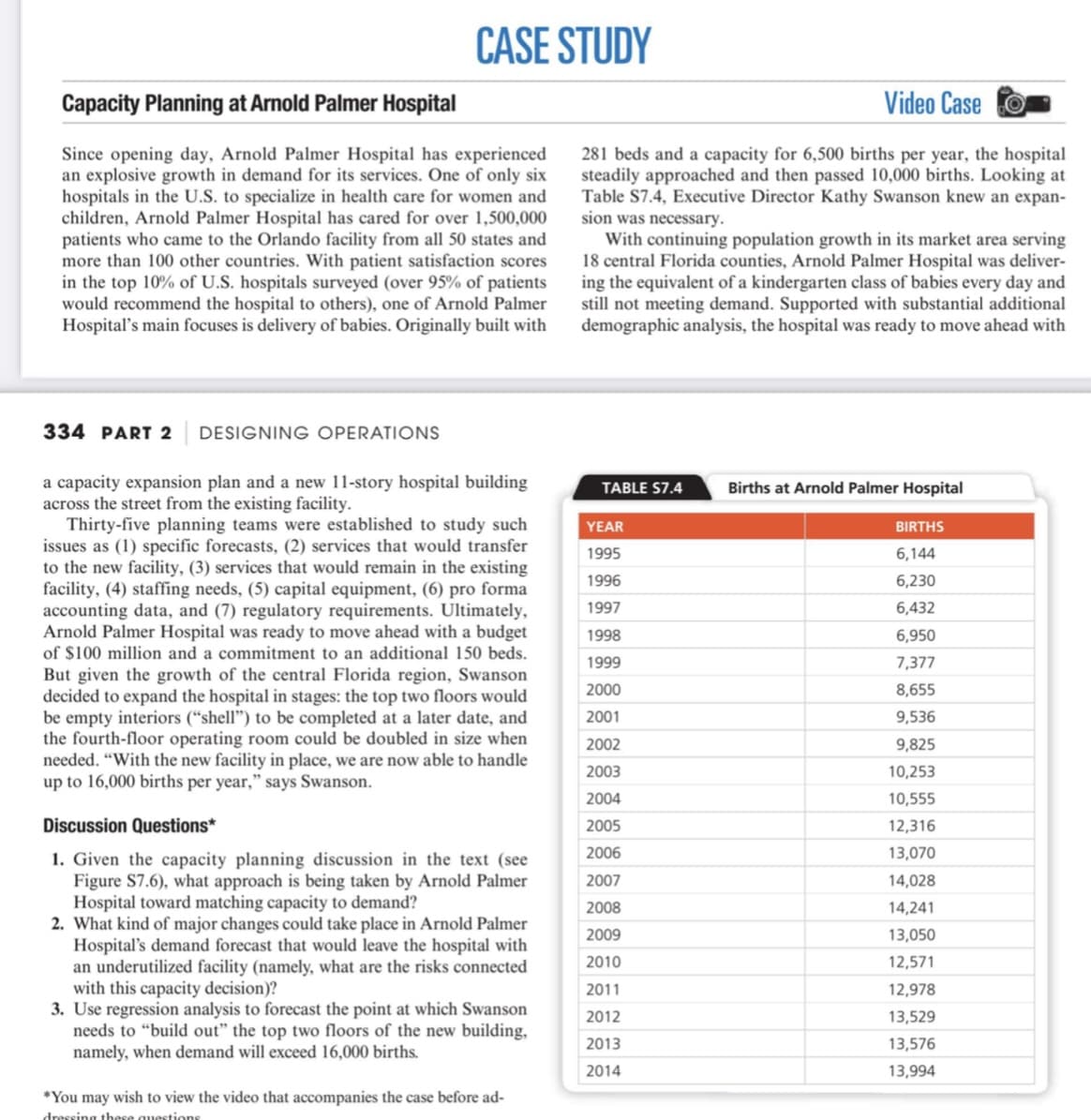CASE STUDY Capacity Planning at Arnold Palmer Hospital Video Case Since opening day, Arnold Palmer Hospital has experienced an explosive growth in demand for its services. One of only six hospitals in the U.S. to specialize in health care for women and children, Arnold Palmer Hospital has cared for over 1,500,000 patients who came to the Orlando facility from all 50 states and more than 100 other countries. With patient satisfaction scores in the top 10% of U.S. hospitals surveyed (over 95% of patients would recommend the hospital to others), one of Arnold Palmer Hospital's main focuses is delivery of babies. Originally built with 281 beds and a capacity for 6,500 births per year, the hospital steadily approached and then passed 10,000 births. Looking at Table S7.4, Executive Director Kathy Swanson knew an expan- sion was necessary. With continuing population growth in its market area serving 18 central Florida counties, Arnold Palmer Hospital was deliver- ing the equivalent of a kindergarten class of babies every day and still not meeting demand. Supported with substantial additional demographic analysis, the hospital was ready to move ahead with 334 PART 2 DESIGNING OPERATIONS a capacity expansion plan and a new 11-story hospital building across the street from the existing facility. Thirty-five planning teams were established to study such issues as (1) specific forecasts, (2) services that would transfer to the new facility, (3) services that would remain in the existing facility, (4) staffing needs, (5) capital equipment, (6) pro forma accounting data, and (7) regulatory requirements. Ultimately, Arnold Palmer Hospital was ready to move ahead with a budget of $100 million and a commitment to an additional 150 beds. TABLE S7.4 Births at Arnold Palmer Hospital YEAR BIRTHS 1995 6,144 1996 6,230 1997 6,432 1998 6,950 1999 7,377 But given the growth of the central Florida region, Swanson decided to expand the hospital in stages: the top two floors would be empty interiors ("shell") to be completed at a later date, and the fourth-floor operating room could be doubled in size when needed. "With the new facility in place, we are now able to handle up to 16,000 births per year," says Swanson. 2000 8,655 2001 9,536 2002 9,825 2003 10,253 2004 10,555 Discussion Questions* 2005 12,316 2006 13,070 1. Given the capacity planning discussion in the text (see Figure S7.6), what approach is being taken by Arnold Palmer Hospital toward matching capacity to demand? 2. What kind of major changes could take place in Arnold Palmer Hospital's demand forecast that would leave the hospital with an underutilized facility (namely, what are the risks connected with this capacity decision)? 3. Use regression analysis to forecast the point at which Swanson needs to "build out" the top two floors of the new building, namely, when demand will exceed 16,000 births. 2007 14,028 2008 14,241 2009 13,050 2010 12,571 2011 12,978 2012 13,529 2013 13,576 2014 13,994
Critical Path Method
The critical path is the longest succession of tasks that has to be successfully completed to conclude a project entirely. The tasks involved in the sequence are called critical activities, as any task getting delayed will result in the whole project getting delayed. To determine the time duration of a project, the critical path has to be identified. The critical path method or CPM is used by project managers to evaluate the least amount of time required to finish each task with the least amount of delay.
Cost Analysis
The entire idea of cost of production or definition of production cost is applied corresponding or we can say that it is related to investment or money cost. Money cost or investment refers to any money expenditure which the firm or supplier or producer undertakes in purchasing or hiring factor of production or factor services.
Inventory Management
Inventory management is the process or system of handling all the goods that an organization owns. In simpler terms, inventory management deals with how a company orders, stores, and uses its goods.
Project Management
Project Management is all about management and optimum utilization of the resources in the best possible manner to develop the software as per the requirement of the client. Here the Project refers to the development of software to meet the end objective of the client by providing the required product or service within a specified Period of time and ensuring high quality. This can be done by managing all the available resources. In short, it can be defined as an application of knowledge, skills, tools, and techniques to meet the objective of the Project. It is the duty of a Project Manager to achieve the objective of the Project as per the specifications given by the client.
Please can you help me save question 3)

Trending now
This is a popular solution!
Step by step
Solved in 2 steps with 1 images









